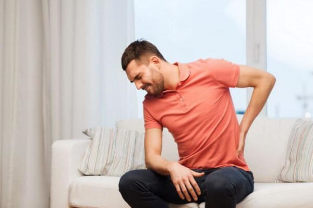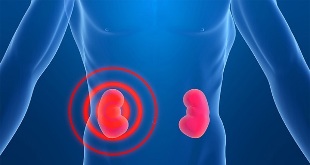
Stiffness in the lower back with a sharp movement bothers many people. Sore kidneys or back how to determine if the feelings are incomprehensible? First and foremost, you need to understand the symptoms of diseases of the spine and vital organs. It will help to have a rough idea of the difference in pain. The main cause of the discomfort is able to determine the doctor, after examination and thorough diagnosis.
Pain in the kidneys or the back – difference of symptoms
Pain attacks in the lumbar spine can immobilize the person for a while. This happens in case of a long stay in the cold or from the effects of drafts. The muscles of the back become inflamed, there is a spasm of the soft tissues, which causes pain in the back, covering the specific region of the spine. Chronic disease (osteochondrosis of the lumbar region) or complications of pathologies of the spine (sciatica) also occur with sharp attacks in the lower back.
The main characteristics of pain in the backThe main signs indicating that a pain occurred due to problems in the back muscles and the spine:
- the emergence of discomfort during lifting heavy burdens or excessive loads on the lumbar spine (prolonged walking, prolonged standing in one place).
- intense pain appears at the time of the various movements of the torso – tilts, turns, changing positions when sitting, lying down;
- discomfort sharply, and fully leaves a person without movement – the patient freezes in that position, which provoked a nasty attack.

Please note! Very often diseases of the back similar to the development of inflammation in the kidneys. In this case, you need to analyze the nature of the pain.
Interestingly, when back pain caused by problems in the spine, the body temperature almost never increases. The exception is the sciatica in the acute and the running form, when the inflammation and swelling in the affected area very large.
There are a number of diseases of the spine, which can trigger a sharp attacks to the back. The most common osteochondrosis, radiculitis, protrusion, herniation in the lumbar spine. The displacement of the vertebrae and the curvature of the backbone, inflammation of muscle and joints also entail difficulties for the movement of the torso lower back. While the discomfort may disappear after giving the body rest.
Important! Back pain caused by disease of the spine can relieve ointments with the effect of warming or wearing a special corset, and kidney problems discomfort in this way does not eliminate.Signs of kidney pains
The main symptoms, giving to understand that the problem lies in the kidneys:
- violation of the bladder (unpleasant cramps in the lower abdomen, painful release of urine, sometimes mixed with blood);
- the appearance of problems with the stomach and intestine (vomiting, nausea, change of chair);
- the presence of pronounced swelling under the eyes and in the legs, which are clearly visible after a night;
- fatigue, lack of energy and sleepiness.

Please note! If you have kidney disease back pain may be accompanied by increased pressure and headaches.The main differences
Striking confirmation of the fact, that hurts the kidney, not the back, is the change in the urine. It gets muddy or loses color. The biological material may be blood, mucus, buy dark tea color.
The difference in symptoms is that back pain in kidney diseases may be accompanied by high temperature. In case of pathologies of the spine fever and chills do not exist.
The difference in the symptoms lies in the fact that pain occurs due to inflammation in the kidneys are not dependent on the position of the body and its movement. While sharp and dramatic attacks in the lower back by reason of diseases of the spine occur because of the tilt, the body turns, changes of poses.
Also determine if the kidneys are sick, not the lower back, possible localization of an attack. The discomfort that most commonly arises from the inflammation of the body, and gives in other areas:
- to the side, grabbing part of the abdomen and groin area;
- in the urogenital system from the outside (external reproductive organs);
- in the area of the urinary ducts;
- in the femoral area on the inside.

These symptoms it is possible to determine where the pain in the kidney or the back. Accurately identify it yourself is impossible. To understand the true cause of the illness to help the doctor.
Specific pain in the lumbar spine in men and women
Quite often a discomfort in the lower back does not belong to the kidneys, no abnormalities of the back. In men, pain may be caused due to contact with the urogenital system infection, which causes inflammation. Prostatitis can also cause discomfort in the back.
Weight lifting, physical exertion and sport activities are also able to provoke in men pain in the lower back. Usually after resting or rubbing with the effect of warming or analgesic ointments the place which is most disturbing, unpleasant sensations disappear.
In women, the back pain often associated with monthly secretions. This is usually a symptom of premenstrual cycle. If we talk about women's diseases that can give back pain, then the inflammation in the ovaries. Discomfort in the back from pathology occur in the middle of the waist or close to the sacrum, without affecting the kidneys. Most times, the pain drawing has character, and is accompanied by sharp pains in the groin or lower abdomen.
The attacks in the lower back may manifest itself as a negative disruption of the bladder (cystitis) and biliary ducts. Such afflictions, in addition to back pain, the cause of women frequent urination in the toilet, embarrassing and painful emission of urine.

Important! During pregnancy is also found discomfort in the back. In this case, the pain can be caused by a significant load on the spine due to the growth of the fetus or to talk about the early struggles.
To determine exactly what hurts, in fact, can only be a specialist after the test. It is important to seek medical help if you have any suspicious symptoms in the back.
Diagnosis of pain in the lower back
To identify the true causes of attacks of low back need to know to what doctor to address. Initially, it is recommended to go to the therapist. He will make a preliminary examination that includes palpation of the most severe pain, will investigate the complaint and will appoint the necessary tests.
To determine whether aching kidney, specialist can make a few light strokes with the side of the palm on the bottom of the back. Any symptoms from the body in response to such manipulation indicate pathology in the kidneys. Before will put a clear diagnosis, you need to undergo a series of research, and then go to a particular doctor.
It's unclear if it's a pain in the kidney or the back, there are the following methods of diagnostics:
- the study of the biological material of the patient (urine, blood);
- an ultrasound of the kidneys on the subject of inflammation, or tumors in paired organs of the urinary system;
- imaging (CT and MRI) of the lumbar spine – the identification of displaced vertebrae, the compression of the nerve fibers and the presence of infections in the affected tissues (if any).

In the case where the integrated diagnostics showed the existence of problems in the musculoskeletal system, the therapist sends the patient to a neurologist and other specialists. It all depends on the revealed pathology. In the case of kidney disease, consult a urologist. Professionals will prescribe an effective treatment that will help fix the problem.
Please note! To determine the source of pain is almost impossible. It is therefore necessary to consult a doctor who will conduct a full diagnosis and prescribe appropriate treatment given the patient.
Back pain in some cases may indicate inflammatory processes in the kidney or abnormalities of the spine. In the early stages of either disease discomfort can be the same. Therefore, people are not always clear, whether aching kidney, and maybe the problem is in the back. To understand the reasons for the occurrence of pain in the lower back to help the doctor. Importantly, at the first signs of discomfort seek medical help, not to run the disease.

























